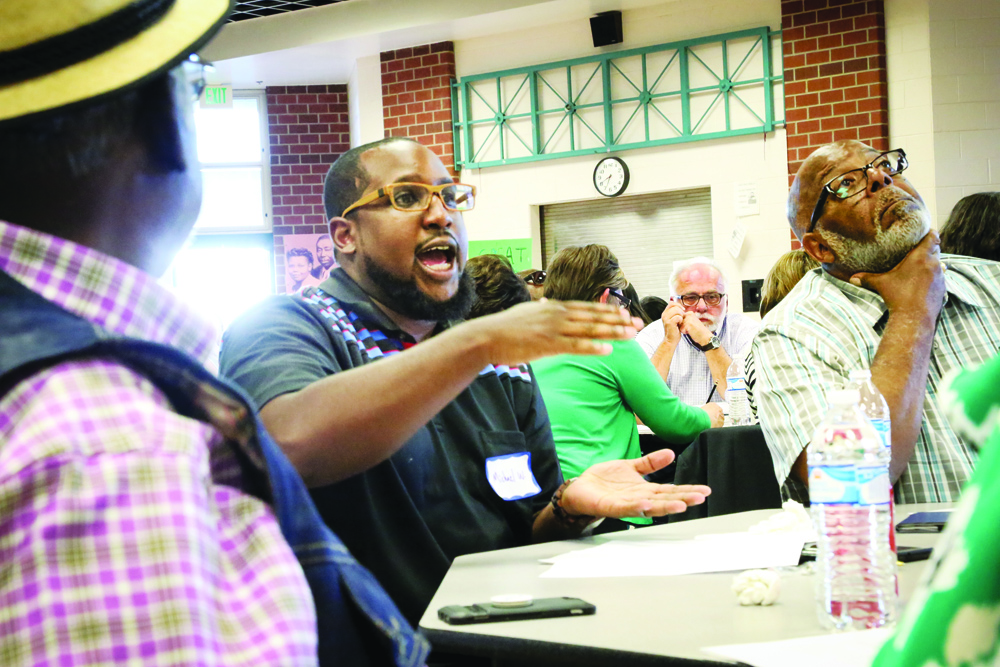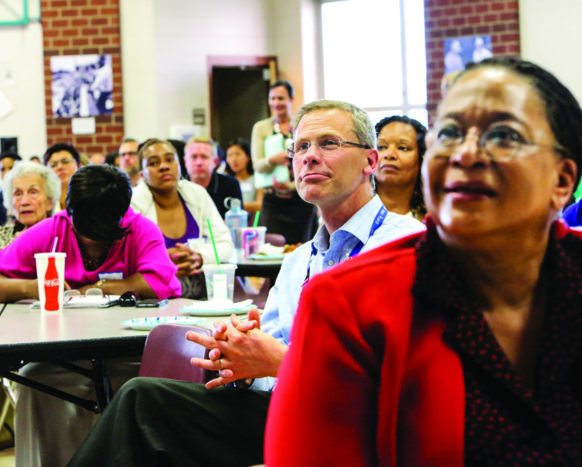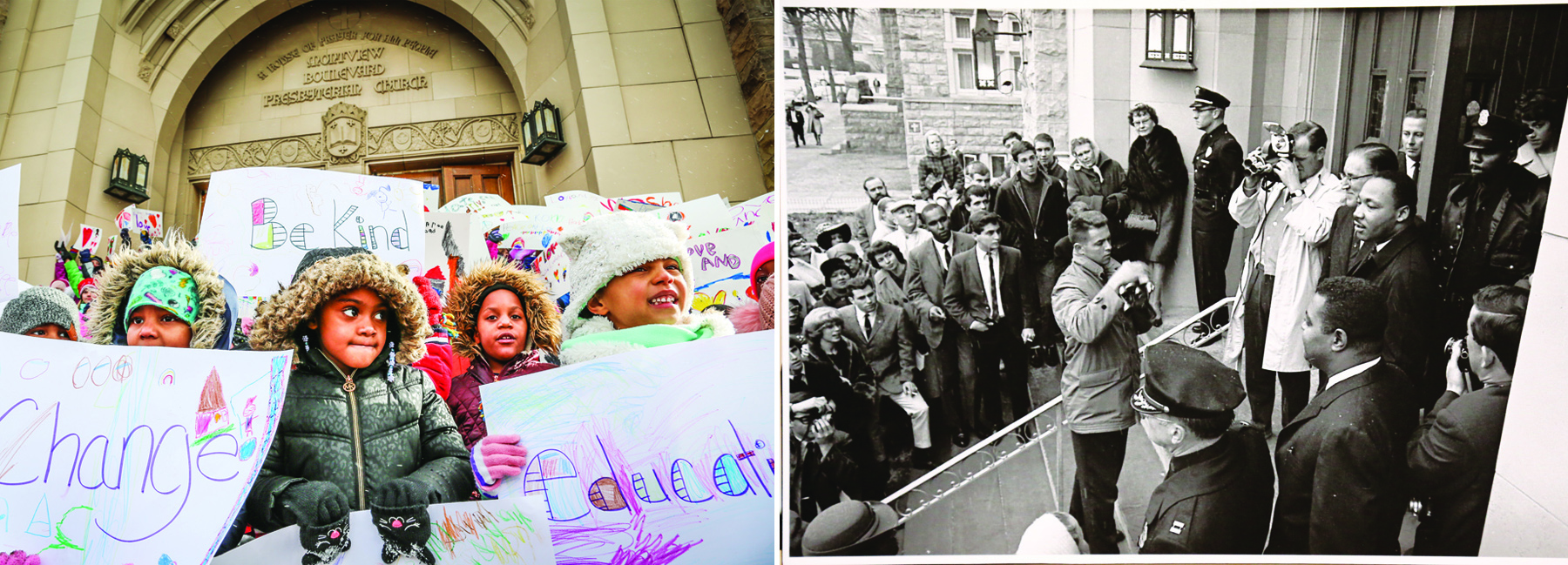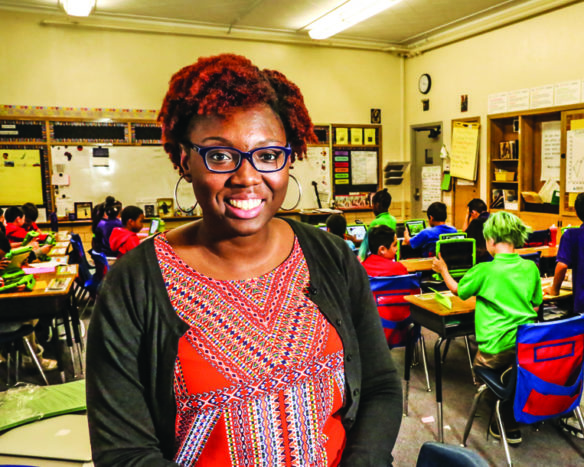
Kindergarten and first grade students from four Park Hill elementary schools sing “We Shall Overcome” on the steps of Montview Presbyterian Church where Martin Luther King spoke to a crowd of 3,000 in 1964.
King’s 1963 “I Have a Dream Speech” envisioned black and white boys and girls together just as they are shown in this photo celebrating him today. But real integration of schools has proven elusive.
In 1954, a unanimous U.S. Supreme Court determined that segregation in public schools violated the 14th Amendment, in the Brown v. Board of Education decision. The following year, the Supreme Court, in what became known as Brown II, instructed states to begin desegregation “with all deliberate speed.” States liberally interpreted that phrase, and many plodded towards integration with the deliberate speed of tortoises.

Michael Williams (AAETF Steering Committee member) speaks out in the Bailey Report meeting.
The National Bureau of Economic Research recently released a study which found that “Black students who’d had just one black teacher by third grade were 13 percent more likely to enroll in college—and those who’d had two were 32 percent more likely.” This wasn’t the first report to find a positive correlation between Black teachers and Black student outcomes. As DPS seeks to reduce the achievement gap, then, why do our schools still have so few Black teachers?

Dr. Sharon Bailey (foreground), former DPS board member, released a report in August 2016 summarizing the concerns of Black educators in DPS. Pictured behind Bailey at a summer 2017 meeting about that report are former Superintendent Tom Boasberg and Anna Jo Haynes (far left).
Though we typically think of Brown v. Board of Education in terms of its impact on students, the Donnell-Kay Foundation hosted a panel discussion to examine Brown’s legacy on Black educators on Jan. 24 at Manual High School. The discussion built on Dr. Michèle Foster’s life histories of Black educators from her book, Black Teachers on Teaching.
After Brown, especially in the South, school districts pushed Black educators and administrators out of the profession. Schools grudgingly integrated Black students but not their former teachers. Since the Brown decision, the number of Black teachers and administrators relative to White teachers and administrators has declined nationally.

500 Kindergarten and first grade students from all four Park Hill Elementary schools looked at the photo of MLK (at right) as they headed up the steps to stand where he had stood 64 years earlier at Montview Presbyterian Church. Park Hill Elementary kindergarten teacher Erika Neale spearheaded the event that took place on Jan. 22. On the steps of Montview Church, they are a picture of integration—but within these four schools, like many others in DPS, racial divides persist. The minority populations of the four schools are 96%, 92%, 69% and 27%.
Even as public-school populations across the country have grown more diverse (DPS’ non-White student population is 76%, of which about 13% is Black), the teaching population has remained predominantly White. According to the Education Trust, “Teachers of color represent only 18 percent of the teaching population in the U.S. (Black teachers are 7 percent.)” The research offers a host of explanations for this “diversity gap,” including fewer undergraduates choosing to major in Education. In many districts, teachers of color are more likely to be placed in low-income, high-minority urban schools where conditions are already extremely challenging, leading to low teacher retention. When these schools fail, these same educators may be left without jobs.

Third grade teacher at Ashley, Branta Lockett.
Third-grade Ashley Elementary teacher Branta Lockett was among the panelists at the Donnell-Kay Foundation event. The child of a schoolteacher, Lockett relays that her mother had hoped she would enter a better-paying profession. She understands her mother’s concerns. “A lot of Blacks don’t go into teaching because of the money…A lot of us cannot afford to teach.”
She shares concern over the ongoing segregation and disparities students face, even in the same neighborhood. “I look at the resources we have at Ashley, and if I cross the street to Stapleton, there are stark differences in resources. It’s hard on teachers. How do we make these resources work? Our students still deserve the best.”
DPS has been aware of its shortage of African American teachers for decades. In 1962, 5.6% of DPS teachers were Black; “A Progress Report to the Board of Education” documented several efforts in 1964-65 to recruit more “Negro” and “Spanish-named applicants.” These efforts seem to have been successful, and by the mid-1970s, 9.7% of DPS teachers were Black and 4.5% were “Chicano” or Hispanic, according to a League of Women Voters report.
Today, however, even after a year that saw greater minority teacher recruitment than ever before (274 total new-to-DPS educators, of whom 4.37% are Black), only 4% of DPS classroom teachers are Black. By comparison, almost 15% of DPS paraprofessionals and 13% of principals are African American. Dr. Sharon Bailey interviewed Black DPS educators and put together a set of recommendations for DPS in 2016; among these was the creation of a professional network to help connect Black educators.
 Allen Smith, Chief of the Culture, Equity & Leadership Team at DPS, cites Reach One Mentoring and Belong affinity groups as two new programs created in response to the recommendations and designed to foster community among teachers of color. Lockett lauds Reach One, which pairs newer teachers of color with mentors, for providing the support she needed as a new teacher. She also credits Ashley’s supportive culture as key to teacher retention. “Our voices are heard.” She hopes DPS will create more programs that foster relationships among teachers of color across schools, since they are otherwise often isolated.
Allen Smith, Chief of the Culture, Equity & Leadership Team at DPS, cites Reach One Mentoring and Belong affinity groups as two new programs created in response to the recommendations and designed to foster community among teachers of color. Lockett lauds Reach One, which pairs newer teachers of color with mentors, for providing the support she needed as a new teacher. She also credits Ashley’s supportive culture as key to teacher retention. “Our voices are heard.” She hopes DPS will create more programs that foster relationships among teachers of color across schools, since they are otherwise often isolated.
Smith, who grew up in a family of teachers, says “This isn’t an issue that was created overnight, and we’re not going to fix it overnight….but we want to do just as good a job retaining our teachers as recruiting them. We don’t want to have this revolving door.” He acknowledges the important role Black teachers have in closing the achievement gap, while observing that an unintended consequence of only focusing on increasing the number of Black teachers in classrooms could place a disproportionate burden on them to close gaps. “We also have to consider whether other (non-Black) teachers are holding our kids to high expectations and truly helping them.” Cultural competency training for teachers can help ensure that all educators have the same high expectations and level of understanding for every child.




0 Comments